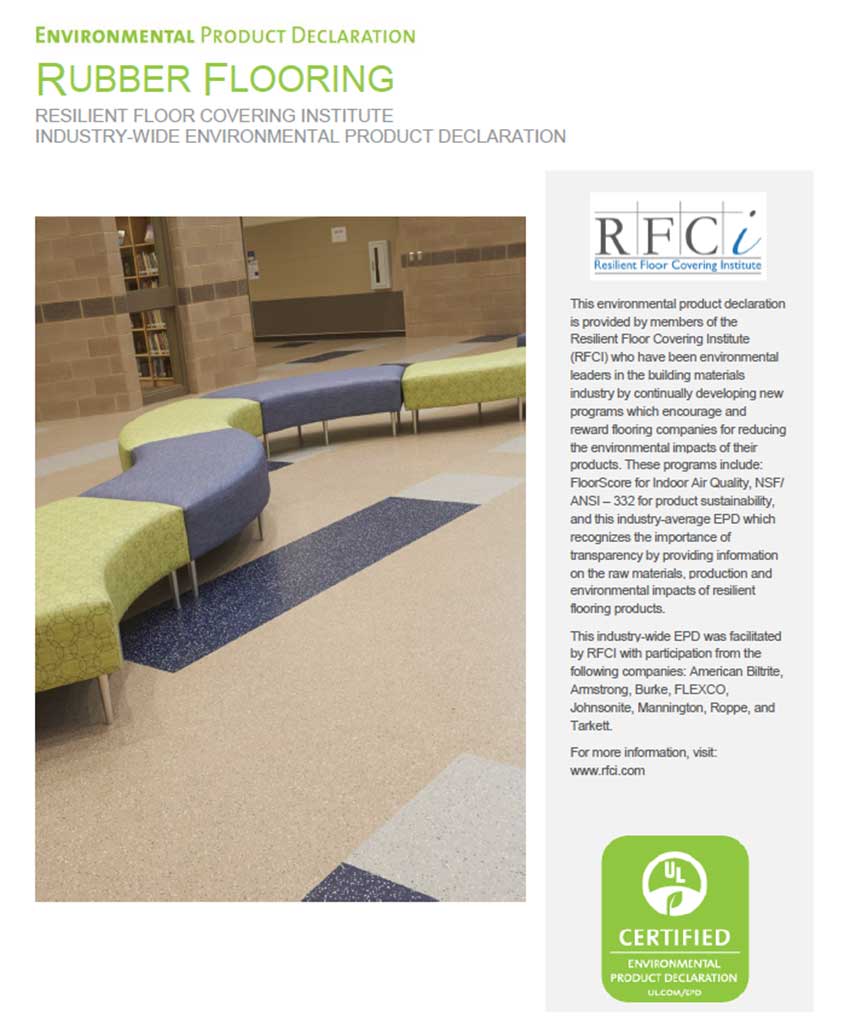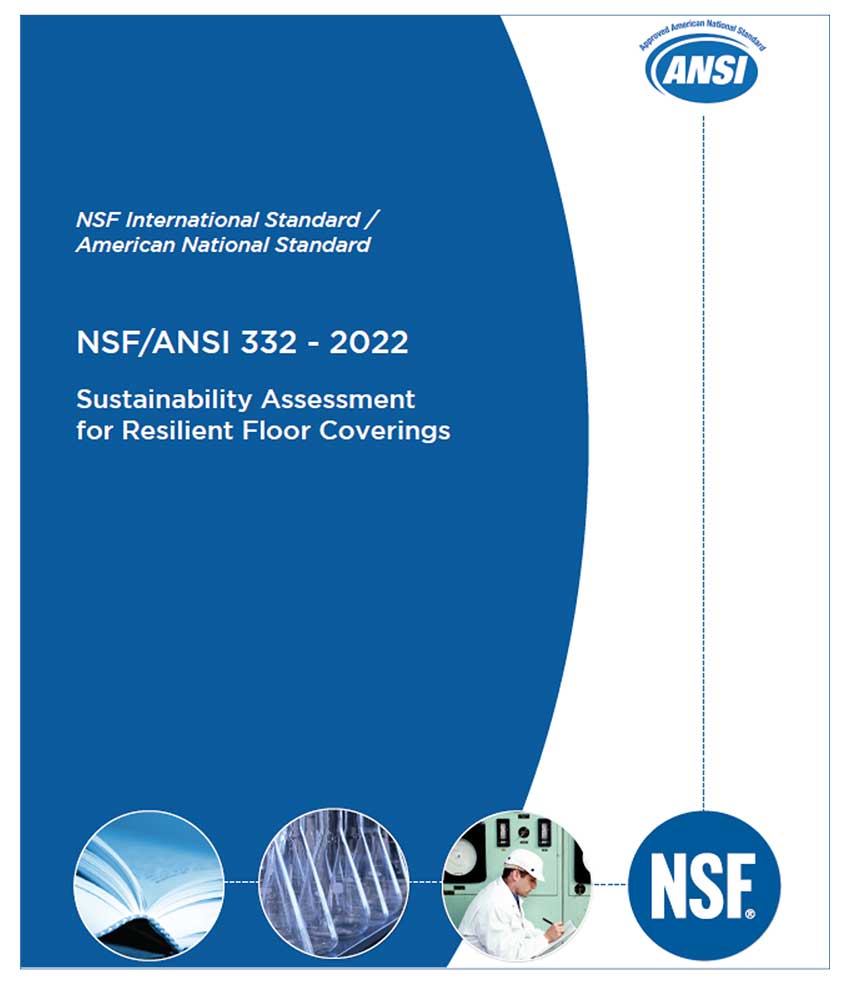Resilient Flooring-Certified!
Why Are EPDs Important?
One question that is often asked is why are EPDs important, and what do they specifically convey about a product? The most recognizable impact that is provided in an EPD is Global Warming Potential (GWP) which impacts climate change. GWP is based on carbon dioxide emissions and makes up the vast majority of Greenhouse Gas Emissions (GHG) per the U.S. Environmental Protection Agency. For products, this is referred to as embodied carbon, and GWP is measured in kilograms of carbon dioxide equivalents (kg of CO2 eq) per functional unit, which for flooring is one square meter. Reducing GWP is one way to combat climate change when specifying products. The goal for optimizing reductions is through measurement and baseline data. If an Industry Wide EPD uses the same Life Cycle Assessment methodology, PCR, functional unit, and product service life, it can be used as a baseline for evaluation of the various impact categories in a Product Specific EPD. The ISO Standards do not directly support comparison; however, comparisons are being used as part of criteria in building rating systems between Industry Wide and Product Specific EPD data. Another baseline being referenced in LEED v4.1 BD+C and ID+C is the comparison between two Product Specific EPDs. The purpose of the comparison is to demonstrate continual improvement of a specific product by a manufacturer, who takes steps to reduce GWP over time.
Typically, there are five additional impact categories evaluated through an LCA and documented in an EPD. These include ozone depletion potential (ODP), acidification potential (AP), eutrophication potential (EP), smog formation potential (SFP), and abiotic depletion potential (fossil fuel). There are additional impacts that can be included within Life Cycle Assessments, however replicable methods and results for measurement are still under development for some other impacts, such as human toxicity.
For compliance with building rating systems, LEED v4.1 BD+C and ID+C and Green Globes – NC, it is encouraged to minimally document products that have either Industry Wide or Product Specific EPDs. Products that evaluate the life cycle stages minimally from Cradle to Gate all garner points within these systems as well as comply with the International Green Construction Code requirements. For additional points, Cradle to Grave garners additional points within Green Globes–NC and comparison of products can garner additional points within LEED v4.1. Evaluating product embodied carbon is one attribute of many that need to be considered, however, there is a direct correlation with evaluating data found in EPDs and reducing Global Warming Potential. Specific information on products and embodied carbon can be found on Building Transparency’s website for the Embodied Carbon Construction Calculator – or EC3. Note that a specifier will find two values for embodied carbon. One is directly from the EPD–Industry Wide or Product Specific and a second value that is calculated based on uncertainty factors, such as grid used, as an EC3 value. The less uncertainty, the better for evaluating a range of GWP for a product.

Photo courtesy of Resilient Floor Covering Institute (RFCI)
Industry Wide Environmental Product Declaration: Rubber Flooring.

Photo courtesy of American Biltrite
Product Specific Environmental Product Declaration: Rubber Flooring: ABPure®.
NSF/ANSI 332 – 2022 Sustainability Assessment for Resilient Floor Coverings
Multi-attribute standards for product certification include requirements for the product manufacturer, the evaluation of supply chain, and the product itself. For resilient flooring, the other certification criteria and EPDs are required within the standard and, in many ways, would be considered a standard that is additive─collecting information from various certifications and declarations to demonstrate a wholistic approach to understanding a product’s baseline and subsequent continuous improvement.

Photo courtesy of Resilient Floor Covering Institute (RFCI)
NSF/ANSI 332-2022 Sustainability Assessment for Resilient Floor Coverings.
In October 2022, the NSF/ANSI 332 Sustainability Assessment for Resilient Floor Coverings (NSF/ANSI 332) standard revision was published for use by resilient floor covering manufacturers. There are three program operators that certify products to this multi-attribute standard – UL, SCS Global, and NSF. The latest version of the standard includes criteria in three impact areas – environmental, health and wellness, and social impacts. The flooring standard can be used for all types of resilient floor covering products.
There are two levels of compliance; Level 1, which includes all criteria to be met to become certified, and Level 2, which requires all Level 1 criteria plus optional criteria with minimum requirements within the three impact areas. These include three Level 2 criteria for environmental impacts, two additional Level 2 criteria for health and wellness impacts, three additional Level 2 criteria for social impacts, and one additional Level 2 criteria from any of the impact areas. If a manufacturer chooses to complete additional Level 2 criteria above and beyond the requirements, they could use this to demonstrate continual improvement in the various impact areas.

Photo courtesy of Roppe
Envire®: Lab Installation: Certified to NSF/ANSI 332 Standard.
Environmental Impacts
The purpose of this section is to understand the Environmental Impacts of ingredients, constituents, chemicals, and the product for use by specifiers to minimize the impacts of sourcing and producing resilient floor coverings. This section highlights requirements for a Type III Industry Wide or Product Specific EPD, a documented Environmental Management System (EMS) to demonstrate that continuous environmental performance targets are met by the manufacturer, water and energy resources utilization plans, a waste minimization management plan, and for those products including vinyl as a feedstock, procurement best practices are required. Greenhouse Gas Emissions (GHG) for Scope 1 and Scope 2 are required, and product service life according to performance standards are to be provided. Product end-of-life and recycling are addressed through extended producer responsibility criteria along with other additional requirements in the above sections that support a Level 2 certification.









